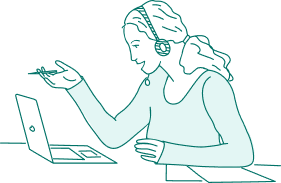What is spastic cerebral palsy?
Spastic cerebral palsy is a developmental disorder caused by damage to the brain before birth, during delivery, or within the first few years of life.
This condition prevents the normal development of motor function.
Spastic CP is characterized by jerky movements, muscle tightness, and joint stiffness.
This type of cerebral palsy often makes simple tasks more challenging, such as walking or picking up small objects. Some children with spastic CP also develop co-occurring conditions as a result of their brain injury. Examples of these coexisting conditions include attention deficit hyperactivity disorder (ADHD) and epilepsy.
Types of spastic CP
There are 4 main types of cerebral palsy, and each CP diagnosis can be further broken down to more accurately describe one's brain damage and related symptoms. The various types of spastic cerebral palsy are classified based on the location of movement issues. For example, children with spastic CP may have muscle stiffness in one arm, both legs or one full side of their body.
- Spastic diplegia affects two limbs, which most commonly are the legs. Children with diplegia may have mild movement issues in the upper body as well. Diplegia is commonly linked to premature birth that results in injury.
 Spastic Diplegia
Spastic Diplegia - Spastic Hemiplegia affects one entire side of the body. The arm is generally more affected than the leg and is distinguished by a rigidly flexed wrist or elbow. Prenatal brain bleeding can lead to hemiplegia.
 Spastic Hemiplegia
Spastic Hemiplegia - Spastic Quadriplegia occurs when all four limbs are affected. The legs are generally impacted more than the arms. Quadriplegia may cause limited control over facial muscles.
 Spastic Quadriplegia
Spastic Quadriplegia
Causes and risk factors
Cerebral palsy is a catch-all term for developmental movement disorders caused by a brain injury. Each type of cerebral palsy is caused by damage to a specific part of the brain.
Spastic cerebral palsy is caused by damage to the motor cortex and the pyramidal tracts of the brain, which connect the motor cortex to the spinal cord. Understanding the function of the motor cortex and pyramidal tracts helps to explain how damage to these systems affects movement in those with spastic CP.
Damage to the motor cortex
The motor cortex is located in the cerebral cortex, which is the largest part of the brain. The motor cortex is composed of several parts that are responsible for relaying signals to other parts of the brain to control movement.
An important aspect of the motor cortex in relation to cerebral palsy is its regulation of voluntary movement. Damage to this region of the brain makes voluntary movement harder to control and less fluid, or "spastic".
Damage to the pyramidal tracts
The pyramidal tracts in the brain are the roads of communication between the cerebral cortex and the nerves in the spinal cord. If pyramidal tracts are damaged, the motor cortex can’t send proper signals to the spinal cord. The spinal cord is one half of the central nervous system, with the other half being the brain and brainstem. These parts of the brain are essential for sensory functions such as sight, touch, and movement.
The motor cortex and pyramidal tracts may be damaged by:
- Prenatal brain hemorrhage or infection
- Lack of oxygen to the brain during birth
- Brain trauma or infection after birth
Several risk factors may increase the likelihood of a developmental brain injury occurring. Poor maternal health and low birth weight are just some of the risk factors for any type of cerebral palsy.
Signs and symptoms
The signs and symptoms of spastic cerebral palsy are different for every child. Differences in symptoms depend on the severity of the child’s brain injury and any co-occurring disorders that may be present.
In general, the most common symptoms of spastic CP are:
- Stiff, tight muscles (hypertonia) on one or both sides of the body
- Exaggerated movements
- Limited mobility
- Abnormal gait
- Crossed knees
- Joints don't fully extend
- Walking on tiptoes
- Contractures
- Abnormal reflexes
Co-occurring issues may also present themselves, such as hearing and vision impairment, but these aren’t directly related to cerebral palsy; they are caused by the initial birth injury.
In the first years of a child’s life, it can be very hard to recognize the signs of cerebral palsy. This is because symptoms typically do not present themselves until a child begins missing developmental milestones. During toddlerhood, many children tend to exhibit some of the same jerky reflexes associated with spastic CP. It can take up to 5 years of age before a full cerebral palsy diagnosis is reached.
Treatment for spastic cerebral palsy
Treatment for spastic CP varies with each case. The severity of symptoms, the location of movement problems, and any secondary conditions are the biggest factors in outlining treatment. However, there are five main routes of treatment for CP: physical, occupational, and speech therapy, medication, and surgery.
Physical therapy
The first type of treatment prescribed to children with spastic CP is typically physical therapy. The goal of physical therapy is to provide as much independence to the child as possible. This treatment is centered on flexibility exercises and stretching out stiff muscles.
Physical therapists will typically use daily range-of-motion (ROM) and stretching exercises to improve the mobility of joints and soft tissues. Physical therapists often use age-appropriate toys and games to make the therapy enjoyable for the child. This type of therapy can help improve overall motor function and prevent any future complications.
Occupational therapy
Another form of therapy used to treat children with spastic CP is occupational therapy. The goal of occupational therapy is to improve a child’s ability to perform daily tasks and activities independently in the home, school, work, and public environments.
Occupational therapists perform exercises that target certain muscles in the wrist, forearm, thumb, and upper body. This treatment is beneficial for spastic CP because it focuses on improving motor control, bilateral coordination, and upper body strength. Occupational therapists can also assess the need for various assistive devices, such as adaptive scissors or writing utensils.
Speech therapy
Speech therapy is used to improve oral movements in children with spastic CP. The objective of speech therapy is to strengthen the muscles used for speech, which helps with articulation and coordination. Some children with this type of CP may experience drooling or difficulty swallowing or speaking. Performing exercises that incorporate assistive communication devices can help improve motor and cognitive abilities, as well as confidence.
Speech therapy provides the tools for children with spastic CP to clearly communicate their thoughts and socialize with others. This form of therapy can also help make chewing, breathing, and swallowing less difficult, allowing for normal growth and development.
Medication
Medications, such as Benzodiazepines, are taken orally to relieve muscle stiffness and improve movement throughout the body. There are also medications that can treat muscle stiffness in specific parts of the body, such as the legs or arms.
For a child with spastic CP that also experiences seizures, doctors often prescribe medications that can control the frequency of these episodes. Similarly, medications such as diazepam (Valium) can be used to relax muscles. This is particularly helpful in treating spasticity in the lower legs. The goal of using medications to treat this type of CP should be to find medications with the most effective results, as well as the lowest amount of negative side effects.
Surgery
Surgery may be a large part of treatment for children with spastic cerebral palsy. There are several types of surgeries that are used to correct joint dislocations, shortened muscles, and sensory impairments that hinder normal motor function.
Selective Dorsal Rhizotomy (SDR) is a common and minimally invasive surgery associated with children who have spastic cerebral palsy. The goal of this spinal surgery is to relax the muscles and improve mobility in various areas.
Life with CP
Every child with CP is different, and some require more treatment than others. A common goal among parents is to give their child the best life possible. There is help available for parents exploring treatment options and the costs associated with their child’s condition.
To learn more about spastic cerebral palsy, try downloading our free Cerebral Palsy Guide. This guide includes over 12 pages of in-depth information for children and parents of a child with CP.


